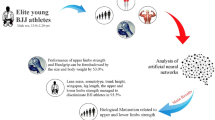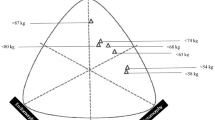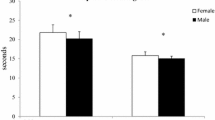Abstract
Purpose
The aim of the study was to examine anthropometric characteristics and neuromuscular function in young judo athletes by sex, age and weight category.
Methods
146 child and cadet judo athletes were examined for height, body mass (BM), body fat percentage (BF), countermovement jump (CMJ), sit-and-reach (SAR) test and handgrip muscle strength (HMS).
Results
The results showed that male adolescents were taller, had more HMS, and less BF and flexibility than girls. Significant differences in the sex and weight category were observed, chiefly in BF and body mass index. There were no differences in time to peak force of HMS and CMJ.
Conclusions
Based on these findings, special attention should be put to heavy BM categories targeting low BF and high muscle mass, which might contribute to improved neuromuscular function and in turn contribute to the dynamics randori. This study might help profiling the young judoka taking into account sex, age and BM category.
Similar content being viewed by others
References
Degoutte F, Jouanel P, Filaire E (2003) Energy demands during a judo match and recovery. Br J Sports Med 37(3):245–249
Hernández R, Torres-Luque G, Olmedilla A (2009) Relations among training volume, body weight, and profile of mood states for elite judoka during a competitive period. Percept Mot Skills 109(3):870–880
Hernández-García R, Torres-Luque G, Villaverde-Gutierrez C (2009) Physiological requirements of judo combat. Int SportMed J 10(3):145–151
Federation IJ (2014) Rules of Judo. IJT
Franchini E, Del Vecchio FB, Matsushigue KA, Artioli GG (2011) Physiological profiles of elite judo athletes. Sports Med 41(2):147–166
Franchini E, Takito MY, Kiss MAPDM, Sterkowicz S (2005) Physical fitness and anthropometrical differences between elite and non-elite judo players. Biol Sport 22(4):315–328
Garatachea N, Hernández-García R, Villaverde C, González-Gallego J, Torres-Luque G (2012) Effects of 7-weeks competitive training period on physiological and mental condition of top level judoists. J Sports Med Phys Fitness 52(1):1–10
Prouteau S, Benhamou L, Courteix D (2006) Relationships between serum leptin and bone markers during stable weight, weight reduction and weight regain in male and female judoists. Eur J Endocrinol 154(3):389–395
Sbriccoli P, Bazzucchi I, Di Mario A, Marzattinocci G, Felici F (2007) Assessment of maximal cardiorespiratory performance and muscle power in the Italian olympic judoka. J Strength Cond Res 21(3):738–744
Sertic H, Segedi I, Molanovic D (2006) Anthropological and fitness status of Croatian judoists. Arch Budo 2(1):24–27
Little NG (1991) Physical performance attributes of junior and senior women, juvenile, junior, and senior men judo athletes. J Sports Med Phys Fitness 31(4):510–520
Franchini E, Huertas J, Sterkowicz S, Carratalá V, Gutiérrez-García C, Escobar-Molina R (2011) Anthropometrical profile of elite Spanish judoka: comparative analysis among ages. Arch Budo 7(4):239–245
Bonitch J (2006) Evolution of muscle strength related to the production and clearance of lactate in successive judo bouts (In Spanish). University of Granada, Spain
Nikolaidis P, Calleja-González J, Padulo J (2014) The effect of age on positional differences in anthropometry, body composition, physique and anaerobic power of elite basketball players. Sport Sci Health
Nikolaidis PT, Karydis NV (2011) Physique and body composition in soccer players across adolescence. Asian J Sports Med 2(2):75–82
Nikolaidis PT (2012) Age-related differences of hamstring flexibility in male soccer players. Balt J Phys Act 4(2):110–115
Nikolaidis PT (2012) Development of isometric muscular strength in adolescent soccer players. Facta Univ Phys Educ Sport 10(3):231–242
Nikolaidis PT (2014) Age-related differences in countermovement vertical jump in soccer players 8-31 years old: the role of fat-free mass. Am J Sports Sci Med 2(2):60–64
Aragon-Vargas LF (2000) Evaluation of four vertical jump tests: methodology, reliability, validity, and accuracy. Meas Phys Educ Exerc Sci 4(4):215–228
Wells KF, Dillon EK (1952) The sit and reach. A test of back and leg flexibility. Res Q Exerc Sport 23:115–118
Cohen J (1988) Statistical power analysis for the behavioral sciences, 2nd edn. Lawrence Erlbaum Associates, Hillsdale
Batterham AM, Hopkins WG (2006) Making meaningful inferences about magnitudes. Int Sports Physiol Perform 1(1):50–57
Franchini E, Nunes AV, Moraes JM, Del Vecchio FB (2007) Physical fitness and anthropometrical profile of the Brazilian male judo team. J Physiol Anthropol 26(2):59–67
Finaud J, Degoutte F, Scislowski V, Rouveix M, Durand D, Filaire E (2006) Competition and food restriction effects on oxidative stress in judo. Int J Sports Med 27(10):834–841
Yoshioka Y, Umeda T, Nakaji S, Kojima A, Tanabe M, Mochida N, Sugawara K (2006) Gender differences in the psychological response to weight reduction in judoists. Int J Sport Nutr Exerc Metab 16(2):187–198
Torres-Luque G, Hernández-García R, Garatachea N (2011) Anthropometric variations over a competitive period in elite judoka. RICYDE 7(24):203–215
Callister R, Callister RJ, Staron RS, Fleck SJ, Tesch P, Dudley GA (1991) Physiological characteristics of elite judo athletes. Int J Sports Med 12(2):196–203
Pocecco E, Faulhaber M, Franchini E, Burtscher M (2012) Aerobic power in child, cadet and senior judo athletes. Biol Sport 29(3):217–222
Hernández-Garcia R, Torres-Luque G (2007) An analysis of competition in judo. Int J Med Sci Phys Activ Sport 25 (article 46)
Krstulovic S, Kvesic M, Nurkic M (2010) Judo training is more effective in fitness development than recreational sports in 7 year old girls. Facta Univ Phys Educ Sport 8:71–79
Sekulic D, Krstulovic S, Katic R, Ostojic L (2006) Judo training is more effective for fitness development than recreational sports for 7-year-old boys. Pediatr Exer Sci 18(3):329–338
Fukuda DH, Stout JR, Kendall KL, Smith AE, Wray ME, Hetrick RP (2013) The effects of tournament preparation on anthropometric and sport-specific performance measures in youth judo athletes. J Strength Cond Res 27(2):331–339
Franchini E, Takito MY, Matheus L, Brito-Vieira DE, Kiss MA (1997) Composição corporal, somatótipo e força isométrica em atletas da seleção brasileira universitária de judô. Âmbito Medicina Esportiva 3(3):21–29
Farmosi I (1980) Body-composition, somatotype and some motor performance of judoists. J Sports Med Phys Fitness 20(4):431–434
Matsumoto Y, Ogawa S, Asami T (1972) A follow-up study of the physical fitness of judoists (report I and II). Bull Assoc Sci Study Judo 4:1–26
Tumilty DM, Hahn AG, Telford RD (1986) A physiological profile of well-trained male judo players. Paper presented at the VIII commonwealth and international conference on sport, physical education, dance, recreation and health, London
Ishiko T, Tomiki K (1972) Characteristics of physical fitness of middle and old age judoists. Bull Assoc Sci Study Judo 4:27–34
Ortega FB, Artero EG, Ruiz JR, España-Romero V, Jiménez-Pavón D, Vicente-Rodriguez G, Moreno LA, Manios Y, Béghin L, Ottevaere C, Ciarapica D, Sarri K, Dietrich S, Blair SN, Kersting M, Molnar D, González-Gross M, Gutiérrez A, Sjöström M, Castillo MJ (2011) Physical fitness levels among European adolescents: the HELENA study. Br J Sports Med 45(1):20–29
Chaabène H, Hachana Y, Franchini E, Mkaouer B, Chamari K (2012) Physical and physiological profile of elite karate athletes. Sports Med 42(10):829–843
Acknowledgments
We thank all participants, their parents and coaches for their collaboration.
Conflict of interest
The authors declare no conflict of interest.
Ethical approval
All procedures performed in studies involving human participants were in accordance with the ethical standards of the local institutional review board (Catholic University San Antonio of Murcia) and with the 1964 Helsinki declaration and its later amendments or comparable ethical standards.
Informed consent
Informed consent was obtained from all individual participants included in the study.
Author information
Authors and Affiliations
Corresponding author
Rights and permissions
About this article
Cite this article
Torres-Luque, G., Hernandez-Garcia, R., Garatachea, N. et al. Anthropometric characteristics and neuromuscular function in young judo athletes by sex, age and weight category. Sport Sci Health 11, 117–124 (2015). https://doi.org/10.1007/s11332-015-0218-0
Received:
Accepted:
Published:
Issue Date:
DOI: https://doi.org/10.1007/s11332-015-0218-0




